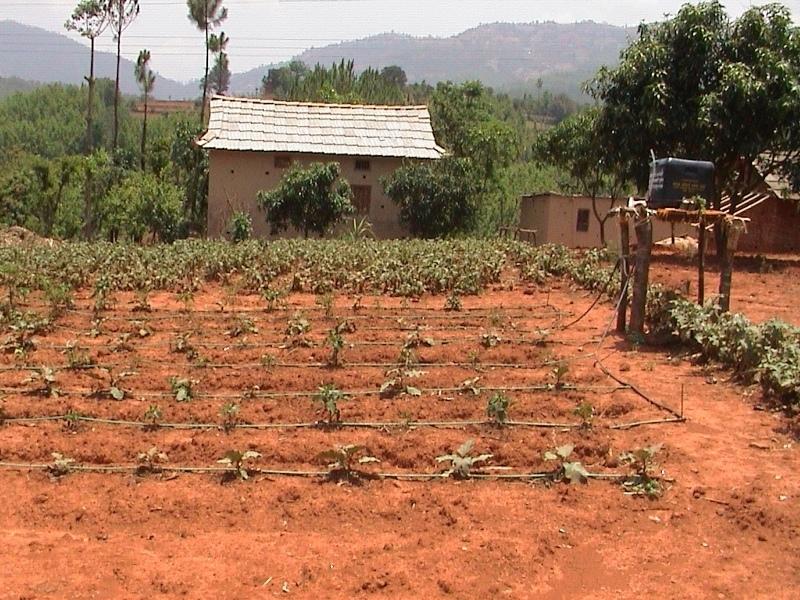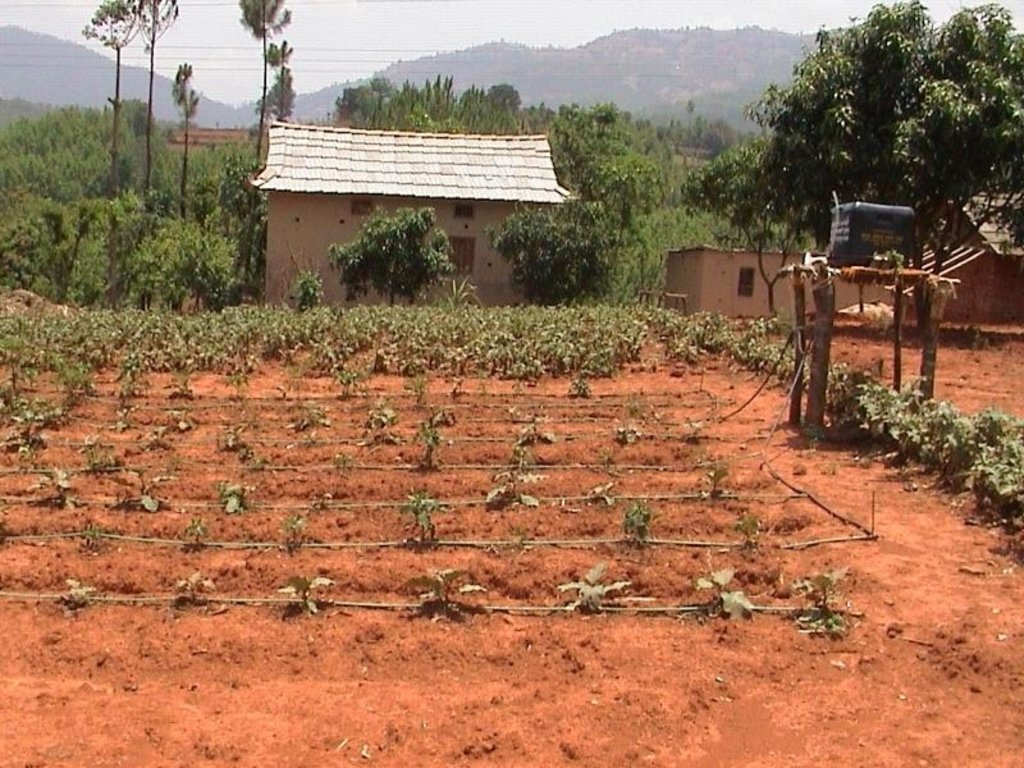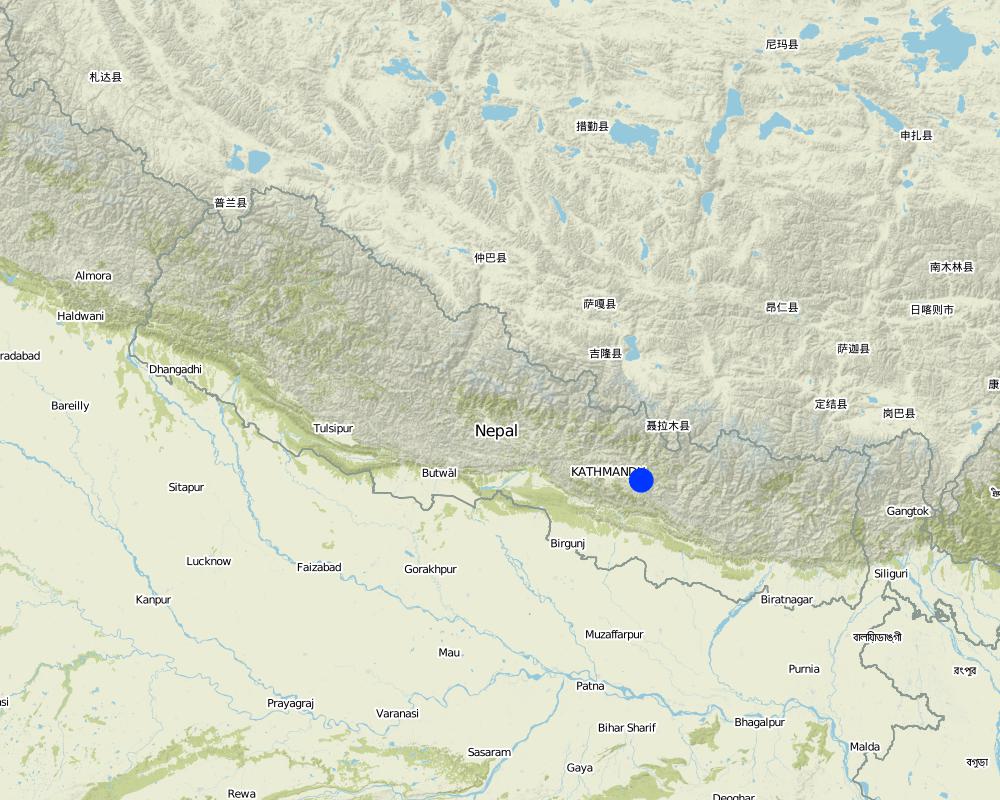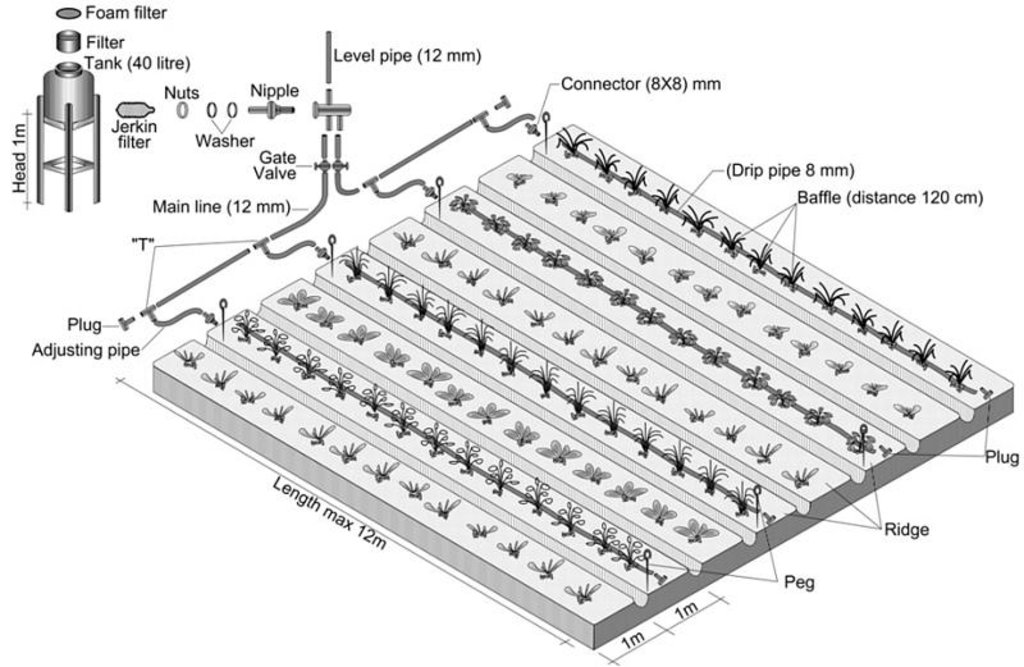Low cost drip irrigation [Nepal]
- Creación:
- Actualización:
- Compilador: Madhav Dhakal
- Editor: –
- Revisores: David Streiff, Alexandra Gavilano
Thopa Sichaee (Nepali)
technologies_1501 - Nepal
Visualizar secciones
Expandir todo Colapsar todos1. Información general
1.2 Detalles de contacto de las personas de referencia e instituciones involucradas en la evaluación y la documentación de la Tecnología
Especialista MST:
Especialista MST:
Adhikari Krishna
PARDYP/ICIMOD
Nepal
Especialista MST:
Shrestha-Malla Smita
PARDYP/ICIMOD
Nepal
Especialista MST:
Nombre del proyecto que financió la documentación/ evaluación de la Tecnología (si fuera relevante)
People and Resource Dynamics Project, Nepal (PARDYP)Nombre de la(s) institución(es) que facilitaron la documentación/ evaluación de la Tecnología (si fuera relevante)
ICIMOD International Centre for Integrated Mountain Development (ICIMOD) - Nepal1.3 Condiciones referidas al uso de datos documentados mediante WOCAT
El compilador y la/s persona(s) de referencia claves aceptan las condiciones acerca del uso de los datos documentados mediante WOCAT:
Sí
1.5 Referencia al (los) Cuestionario(s) de Enfoques MST (documentados usando WOCAT)
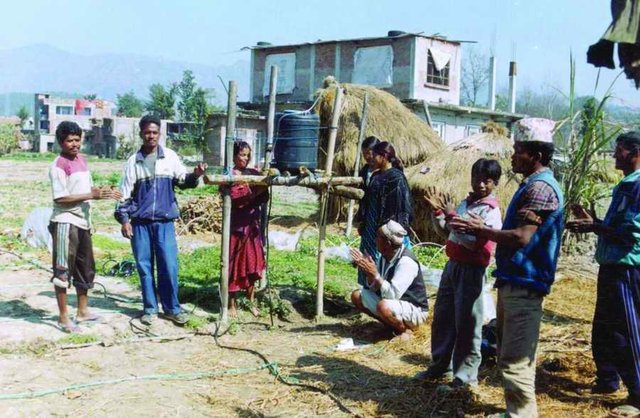
Participatory action research on drip irrigation [Nepal]
Conducting participatory action research with farmers and line agencies for demonstrating, disseminating and scaling up drip irrigation.
- Compilador: Madhav Dhakal
2. Descripción de la Tecnología MST
2.1 Breve descripción de la Tecnología
Definición de la Tecnología:
An irrigation system which allows the slow and precise delivery of water to crops
2.2 Descripción detallada de la Tecnología
Descripción:
Drip irrigation is a very water-efficient irrigation system. Water is dripped to individual plant root zones at low rates (2.25 l/hr) from emitters embedded in small diameter plastic pipes.
Farmers in the Jhikhu Khola watershed, Nepal, suffer from a shortage of water for irrigation between the end of one monsoon (June to September) and the next pre-monsoon period (May). This seriously limits agricultural production and leads to much land being left fallow after the monsoon crops have been harvested. Only a small area is planted with winter crops. The sources of irrigation water (such as rivers, and streams) are limited and the amount of water they provide is inadequate for cropping. Most of the sources remain dry outside the monsoon. Farmers expend considerable time and labour gathering what water they can to irrigate their crops. Low cost drip irrigation (LCDI) has been introduced in the watershed as a cost effective way of making the best use of the limited available water.
The cropping pattern of this area sees pre-monsoon vegetables established in February and March and winter vegetables in September and October. The low cost drip irrigation sets are installed while the fields are being prepared by ploughing, levelling, and ridging. Lateral pipes (12m long) are laid along the ridges which lie 1.5m apart. A wooden platform with storage tank is installed and connected to the lateral pipes. After the lateral pipes are laid out, planting holes are dug along the ridges spaced to coincide with the drip holes. These holes are usually set every 0.6 or 1.2m along the pipes depending on the crop. Farmyard manure and chemical fertiliser is placed in each pit and mixed well with the soil. Next, vegetable seedlings are planted in each hole and daily drip watering begins. Bitter gourd is the most commonly grown crop followed by cauliflower. Irrigation water is generally applied either in the morning or the evening. If needed, stakes are placed next to each plant a week later to allow the plants to climb. The climber crops like bitter gourd are netted one month after planting to provide more space for fruiting. Harvesting starts in mid-May and continues until September. Farmers maintain the system by repairing leaks in the pipe joints and by unblocking blocked drip holes.
2.3 Fotografías de la Tecnología
2.5 País/ región/ lugares donde la Tecnología fue aplicada y que se hallan comprendidos por esta evaluación
País:
Nepal
Región/ Estado/ Provincia:
Bagmati zone
Especifique más el lugar :
Kavepalanchowk/Jhikhu Khola watershed
Especifique la difusión de la Tecnología:
- distribuida parejamente sobre un área
Si se desconoce el área precisa, indique el área aproximada cubierta:
- < 0.1 km2 (10 ha)
Comentarios:
The technology was first introduced in the Jhikhu Khola watershed ( JKW) in 1993 with the support from University of British Columbia (UBC) but due to the technical problems it stopped in the same year. The drip sets introduced for the first time was North American type, and spare parts were not available after malfunctioning. Later on , from Oct. 2000 to Jan.2001, UBC again conducted experiments using two different types of drip sets , i.e. LCDI and Western Type ( Stefanie 2002) This experiment was conducted on Cauliflower. People and Resource Dynamics Project with the collaboration of Institute of engineering , Tribhuban University has initiated the drip experiment on cauliflower in Hokse ( Kubinde) in November 1999. In 2000 and 2001 the drip experiments were conducted on bitter gourd at Horticultural center( Panchkhal). From 2001 onwards it was introduced to the farmers field.
For this study, most of the discussions will be concentrated on Bitter gourd grown under drip in Panchkhal.
Map
×2.6 Fecha de la implementación
Si no se conoce el año preciso, indique la fecha aproximada:
- hace menos de 10 años (recientemente)
2.7 Introducción de la Tecnología
Especifique cómo se introdujo la Tecnología:
- mediante proyectos/ intervenciones externas
Comentarios (tipo de proyecto, etc.):
Concept of drip irrigation came from Israel. LCDI was introduced by IDE/Nepal
3. Clasificación de la Tecnología MST
3.1 Propósito(s) principal(es) de la Tecnología MST
- Reduce water input
3.2 Tipo(s) actuales de uso de la tierra donde se aplica la Tecnología

Tierras cultivadas
- Cosecha anual
- Cosecha de árboles y arbustos
Cosechas anuales - Especifique cultivos:
- cereales - cebada
- cereales - maíz
- cultivos de raíces/ tubérculos - patatas
- cultivos de semillas - sésamo, amapola, mostaza, otros
- vegetales - otros
- rice, wheat
Cultivos de matorrales y arbustos - Especifique cultivos:
- árboles para forraje (Calliandra, Leucaena leucocephala, Prosopis, etc.)
- frutas, otros
Número de temporadas de cultivo por año:
- 3
Especifique:
Longest growing period in days: 150 Longest growing period from month to month: Jun - Oct Second longest growing period in days: 120 Second longest growing period from month to month: Nov - Feb
Comentarios:
major cash crop: Tomato, potato, vegetables
major food crop: Rice , wheat , maize
other: Mustard, barley, fodder trees, fruit trees
Major land use problems (compiler’s opinion): Insufficient water limits agricultural production during the winter and pre-monsoon seasons (Nov-May) leading to low farm incomes from the small landholdings. The increasing inputs of chemical fertilisers are a matter of concern for environmental protection.
Major land use problems (land users’ perception): Irrigation water shortage for the crops grown during winter and premonsoon months.
Type of cropping system and major crops comments: Rain fed land: Maiz-Wheat /vegetables. Irrigated land: Rice - vegetables/Wheat-vegetabes/ Maize
3.4 Provisión de agua
Provisión de agua para la tierra donde se aplica la Tecnología:
- de secano
Comentarios:
Water supply: Also mixed rainfed - irrigated
3.5 Grupo MST al que pertenece la Tecnología
- Manejo de irrigación: (incl. provisión de agua, invernaderos)
3.6 Medidas MST que componen la Tecnología

medidas de manejo
- M2: Cambio de gestión/ nivel de intensidad
3.7 Principales tipos de degradación del suelo encarados con la Tecnología

degradación del agua
- Hs: cambio en la cantidad de aguas superficiales
Comentarios:
Main causes of degradation: urbanisation and infrastructure development (poor irrigation infrastructres), other natural causes (avalanches, volcanic eruptions, mud flows, highly susceptible natural resources, extreme topography, etc.) specify (uneven distribution of precipitation throughout the year.), poverty / wealth (lack of captial - limited fund allocated from government for the irrigation infrastructure development and maintenance), labour availability (lack of labour - out migration for off-farm employment), education, access to knowledge and support services (lack of knowledge - approapriate technologies and the approach to implement them)
Secondary causes of degradation: other human induced causes (specify) (agricultural causes - increased dose of agrochemical use, poor seed qality), land tenure (land subdivision - population growth , separating family members from a household.)
3.8 Prevención, reducción o restauración de la degradación del suelo
Especifique la meta de la Tecnología con relación a la degradación de la tierra:
- reducir la degradación del suelo
4. Especificaciones técnicas, actividades de implementación, insumos y costos
4.1 Dibujo técnico de la Tecnología
Especificaciones técnicas (relacionadas al dibujo técnico):
Technical parts and design of a low cost drip irrigation system
Location: Jhikhu Khola watershed. Kabrepalanchowk/
Technical knowledge required for field staff / advisors: high
Technical knowledge required for land users: moderate
Main technical functions: increase / maintain water stored in soil, slow and precise delivery of water to plant root zones, enhanced phot*
Secondary technical functions: reduction of evaporation losses*, reduction of water distribution losses*
Change of land use practices / intensity level: from conventional irrigation flood/ bucket) to efficient irrigation
Autor:
IDE Nepal
4.2 Información general sobre el cálculo de insumos y costos
Especifique cómo se calcularon los costos e insumos:
- por unidad de Tecnología
Especifique unidad:
Drip irrigation system
Especifique las dimensiones de la unidad (si fuera relevante):
150 square meter
Especifique la moneda usada para calcular costos:
- USD
Indique el costo promedio del salario de trabajo contratado por día:
2.80
4.3 Actividades de establecimiento
| Actividad | Momento (estación) | |
|---|---|---|
| 1. | Connection of the lateral pipes to the water storage tank | February/March |
| 2. | Opening and closing of gate valves | February/March |
| 3. | Levelling of land for uniform water distribution | February/ March ( if required) |
| 4. | Construction of wooden platform to raise the storage tank generally | February/March |
| 5. | Installation of lateral pipes along the ridges/beds;check the spacing | February /March |
| 6. | then dig about 0.5m deep and 0.3m diameter planting pits for | February/March |
4.4 Costos e insumos necesarios para el establecimiento
| Especifique insumo | Unidad | Cantidad | Costos por unidad | Costos totales por insumo | % de los costos cubiertos por los usuarios de las tierras | |
|---|---|---|---|---|---|---|
| Mano de obra | Labour | Persons/day | 1,0 | 2,8 | 2,8 | 100,0 |
| Equipo | Drip set | unit | 1,0 | 25,8 | 25,8 | |
| Costos totales para establecer la Tecnología | 28,6 | |||||
| Costos totales para establecer la Tecnología en USD | 28,6 | |||||
Comentarios:
Duration of establishment phase: 6 month(s)
4.5 Actividades de establecimiento/ recurrentes
| Actividad | Momento/ frequencia | |
|---|---|---|
| 1. | Prevent leakage by replacing damaged or worn out parts | / as per need |
| 2. | Clean the drip holes with water and a pin | / as per need |
4.6 Costos e insumos necesarios para actividades de mantenimiento/ recurrentes (por año)
| Especifique insumo | Unidad | Cantidad | Costos por unidad | Costos totales por insumo | % de los costos cubiertos por los usuarios de las tierras | |
|---|---|---|---|---|---|---|
| Mano de obra | Cleaning drip holes | Persons/day | 1,43 | 2,8 | 4,0 | 100,0 |
| Equipo | Replacing damaged parts | unit | 1,0 | 300,0 | 300,0 | 100,0 |
| Indique los costos totales para mantenecer la Tecnología | 304,0 | |||||
| Costos totales para mantener la Tecnología en USD | 304,0 | |||||
Comentarios:
Machinery/ tools: spade
The cost is calculated for 150 square meter area , and extrapolated to per hectar of land. Only costs are listed which are additional to the traditional way of growing bitter gourd with out drip. Cost estimated in 2006.
5. Entorno natural y humano
5.1 Clima
Lluvia anual
- < 250 mm
- 251-500 mm
- 501-750 mm
- 751-1,000 mm
- 1,001-1,500 mm
- 1,501-2,000 mm
- 2,001-3,000 mm
- 3,001-4,000 mm
- > 4,000 mm
Zona agroclimática
- húmeda
Thermal climate class: subtropics
5.2 Topografía
Pendientes en promedio:
- plana (0-2 %)
- ligera (3-5%)
- moderada (6-10%)
- ondulada (11-15%)
- accidentada (16-30%)
- empinada (31-60%)
- muy empinada (>60%)
Formaciones telúricas:
- meseta/ planicies
- cordilleras
- laderas montañosas
- laderas de cerro
- pies de monte
- fondo del valle
Zona altitudinal:
- 0-100 m s.n.m.
- 101-500 m s.n.m.
- 501-1,000 m s.n.m
- 1,001-1,500 m s.n.m
- 1,501-2,000 m s.n.m
- 2,001-2,500 m s.n.m
- 2,501-3,000 m s.n.m
- 3,001-4,000 m s.n.m
- > 4,000 m s.n.m
Comentarios y especificaciones adicionales sobre topografía :
Altitudinal zone: 850 m a.s.l.
5.3 Suelos
Profundidad promedio del suelo:
- muy superficial (0-20 cm)
- superficial (21-50 cm)
- moderadamente profunda (51-80 cm)
- profunda (81-120 cm)
- muy profunda (>120 cm)
Textura del suelo (capa arable):
- mediana (limosa)
Materia orgánica de capa arable:
- media (1-3%)
- baja (<1%)
Si se halla disponible, adjunte una descripción completa de los suelos o especifique la información disponible, por ej., tipo de suelo, pH/ acidez de suelo, capacidad de intercambio catiónico, nitrógeno, salinidad, etc. :
Soil fertility is medium
Soil drainage / infiltration is good
Soil water storage capacity is medium
5.4 Disponibilidad y calidad de agua
Disponibilidad de aguas superficiales:
pobre/ ninguna
Calidad de agua (sin tratar):
agua potable de mala calidad (requiere tratamiento)
Comentarios y especificaciones adicionales sobre calidad y cantidad de agua:
Availability of surface water: More in rainy season (June- September), less in April/May
Water quality (untreated): Also good drinking water but poor in rainy season (June- September), less in April/May source: Natural spring
5.6 Las características de los usuarios de la tierra que aplican la Tecnología
Orientación del mercado del sistema de producción:
- mixta (subsistencia/ comercial)
- comercial/ mercado
Ingresos no agrarios:
- 10-50% de todo el ingreso
Nivel relativo de riqueza:
- pobre
- promedio
Individuos o grupos:
- individual/ doméstico
Nivel de mecanización:
- trabajo manual
- tracción animal
Género:
- mujeres
- hombres
Indique otras características relevantes de los usuarios de las tierras:
Land users applying the Technology are mainly common / average land users
Population density: 200-500 persons/km2
Annual population growth: 2% - 3%
Off-farm income specification: In most farm households, off-farm income plays at least a minor and increasingly a major role. Occasional opportunities for off-farm income present themselves in the form of daily
Market orientation of production system: The technology is suitable for vegetable farming , most of the farmers grow vegetables commercially because of the good market access.
Level of mechanization: Land cultivation performed mostly with locally available tools like spade and animals are used during land preparation (ploughing)
5.7 Área promedio de la tierra usada por usuarios de tierra que aplican la Tecnología
- < 0.5 ha
- 0.5-1 ha
- 1-2 ha
- 2-5 ha
- 5-15 ha
- 15-50 ha
- 50-100 ha
- 100-500 ha
- 500-1,000 ha
- 1,000-10,000 ha
- > 10,000 ha
¿Esto se considera de pequeña, mediana o gran escala (refiriéndose al contexto local)?
- escala mediana
5.8 Tenencia de tierra, uso de tierra y derechos de uso de agua
Tenencia de tierra:
- individual, con título
Derechos de uso de tierra:
- individual
Derechos de uso de agua:
- acceso abierto (no organizado)
6. Impactos y comentarios para concluir
6.1 Impactos in situ demostrados por la Tecnología
Impactos socioeconómicos
Ingreso y costos
gastos en insumos agrícolas
Comentarios/ especifique:
Reduced cost and time for irrigation and applying fertiliser
ingreso agrario
Comentarios/ especifique:
extra income (US$ 700/ha) due to early
carga de trabajo
Comentarios/ especifique:
time for irrigation and fertigation reduced, but cropping area increased due to the technology; this increases the workload of women around 0-5%
Impactos socioculturales
instituciones comunitarias
Comentarios/ especifique:
increased no. of drip users
MST/ conocimiento de la degradación del suelo
Comentarios/ especifique:
land users become familiar
Livelihood and human well-being
Comentarios/ especifique:
Fallow land used for vegetable production; more income for households.
Impactos ecológicos
Ciclo de agua/ escurrimiento de sedimento
evaporación
Comentarios/ especifique:
Reduction of water loses through evaporation , percolation
Suelo
humedad del suelo
Comentarios/ especifique:
due to applying water directly to plants’
pérdida de suelo
Comentarios/ especifique:
due to slow and precise delivery of water into the soil
Otros impactos ecológicos
Mono cropping
Comentarios/ especifique:
majority of farmers grow bitter gourd followed by cauliflower
Technology is not suitable where enough water is available
Comentarios/ especifique:
few farmers abandon the drips
Drip set is not available in local market
Comentarios/ especifique:
there should be provision to get drip sets locally. Presently, every farmer has to approach PARDYP project
6.2 Impactos fuera del sitio demostrados por la Tecnología
disponibilidad de agua
Comentarios/ especifique:
less water used to irrigate crops making more
Risk of increased water consumption
Comentarios/ especifique:
Spread of the system could lead to increased upstream water
6.3 Exposición y sensibilidad de la Tecnología al cambio climático gradual y a extremos relacionados al clima/ desastres (desde la percepción de los usuarios de tierras)
Cambio climático gradual
Cambio climático gradual
| Estación | Incremento o reducción | ¿Cómo es que la tecnología soporta esto? | |
|---|---|---|---|
| temperatura anual | incrementó | no se sabe |
Extremos (desastres) relacionados al clima
Desastres climatológicos:
| ¿Cómo es que la tecnología soporta esto? | |
|---|---|
| tormenta de lluvia local | bien |
| tormenta de viento | bien |
Desastres climatológicos
| ¿Cómo es que la tecnología soporta esto? | |
|---|---|
| sequía | no muy bien |
Desastres hidrológicos
| ¿Cómo es que la tecnología soporta esto? | |
|---|---|
| inundación general (río) | no muy bien |
Otras consecuencias relacionadas al clima
Otras consecuencias relacionadas al clima
| ¿Cómo es que la tecnología soporta esto? | |
|---|---|
| periodo reducido de crecimiento | bien |
6.4 Análisis costo-beneficio
¿Cómo se comparan los beneficios con los costos de establecimiento (desde la perspectiva de los usuarios de tierra)?
Ingresos a corto plazo:
positivo
Ingresos a largo plazo:
muy positivo
¿Cómo se comparan los beneficios con los costos de mantenimiento/ recurrentes (desde la perspectiva de los usuarios de tierra)?
Ingresos a corto plazo:
muy positivo
Ingresos a largo plazo:
muy positivo
Comentarios:
The practice delivers quick and tangible benefits so that users usually get a return on the cost of investment after only one crop season.
6.5 Adopción de la Tecnología
- > 50%
Si tiene la información disponible, cuantifique (número de hogares y/o área cubierta):
50 households in an area of 10 ha
De todos quienes adoptaron la Tecnología, ¿cuántos lo hicieron espontáneamente, por ej. sin recibir nada de incentivos/ materiales:
- 51-90%
Comentarios:
58% of land user families have adopted the Technology with external material support
29 land user families have adopted the Technology with external material support
Comments on acceptance with external material support: survey results
42% of land user families have adopted the Technology without any external material support
21 land user families have adopted the Technology without any external material support
Comments on spontaneous adoption: survey results
There is a strong trend towards spontaneous adoption of the Technology
Comments on adoption trend: Farmers have shown growing interest, no. of drip farmers are increasing year by year, about 50 farmers in the watershed are practicing drip till present. Another 55 farmers are also using the technology with the support from a local NGO ( Ranipani Gram Sewa Samitee) District Soil Conservation Office, (DISCO) Kabhre and District Irrigation Office ( DIO) Kabhre. PARDYP is continuously providing technical support for all ( about 105) the drip users, no of drip users will be increased drastically in coming future if it is easily accessible and sufficient technical knowledge provided to them.
6.7 Fuerzas/ ventajas/ oportunidades de la Tecnología
| Fuerzas/ ventajas/ oportunidades desde la perspectiva del usuario de la tierra |
|---|
|
Dry season ( off season) vegetable production become possible for the areas having limited sources of water. How can they be sustained / enhanced? Technology should be available in the local market |
| Effective irrigation with little amount of water. |
|
Plant to plant visits are not required while irrigating, so irrigation, fertigation, and weeding take less time – the technology needs 50% less labor compared to bucket irrigation How can they be sustained / enhanced? Experience sharing and interactions among drip users and non-users, easy access to technology with necessary trainings |
| Easy fertilizer application with drip. |
| Women farmers self-esteem was enhanced because of drip as they could grow cash crops alone . |
| Fuerzas/ ventajas/ oportunidades desde la perspectiva del compilador o de otra persona de referencia clave |
|---|
|
Drip irrigation saved 60% of water compared to bucket irrigation; dry season (off-season) vegetable production became possible and cropping area increased on areas with limited access to irrigation water How can they be sustained / enhanced? Construction of water harvesting ponds and the use of collected water in drip systems makes for sustainable crop production |
|
Additional household income (~$700/ha) due to early fruiting in case of bitter gourd (comparative study of drip vs. bucket irrigation) How can they be sustained / enhanced? Options for other potential high value cash crops should be explored |
| Soil moisture lasted for longer period, losses from evaporation reduced. |
6.8 Debilidades/ desventajas/ riesgos de la Tecnología y formas de sobreponerse a ellos
| Debilidades/ desventajas/ riesgos desde la perspectiva del usuario de la tierra | ¿Cómo sobreponerse a ellas? |
|---|---|
| The spacing of the drip holes does not match the farmer’s needs | Make pipes available with at least 50 cm distance between drip holes |
| Spare parts are not available in the local market and farmers have to travel far (to Kathmandu) to get spare parts | Make parts available locally |
| Rats damage drip pipe frequently. |
| Debilidades/ desventajas/ riesgos desde la perspectiva del compilador o de otra persona de referencia clave | ¿Cómo sobreponerse a ellas? |
|---|---|
| Technology is not suitable for sloping land and covers only a small area (using a medium-sized kit) | Modifying and levelling slopes and increasing the number of drip kits can overcome this limitation |
| Setup ( fitting) procedure is sophisticated | regular training |
7. Referencias y vínculos
7.1 Métodos/ fuentes de información
7.2 Vínculos a las publicaciones disponibles
Título, autor, año, ISBN:
ICIMOD (2007) Good Practices in Watershed Management, Lessons Learned in the Mid Hills of Nepal. Kathmandu: ICIMOD
¿Dónde se halla disponible? ¿Costo?
ICIMOD
Título, autor, año, ISBN:
Prajapati-Merz, B. (2003) ‘Drip Irrigation System.’ In PARDYP Annual Report 2003 submitted to ICIMOD, Kathmandu
¿Dónde se halla disponible? ¿Costo?
ICIMOD
Título, autor, año, ISBN:
Shrestha, S. (2004) Adoption of Drip Technology and It’s Impact on Gender: a Case Study fromJhikhu Khola Watershed, a report submitted to PARDYP project, ICIMOD, Kathmandu, Nepal
¿Dónde se halla disponible? ¿Costo?
ICIMOD
Título, autor, año, ISBN:
Von Westarp, S. (2002) Agricultural Intensifi cation, Soil Fertility Dynamics, and Low CostDrip Irrigation in the Middle Mountains of Nepal, M.Sc. Thesis. Vancouver: University of British Columbia (UBC)
¿Dónde se halla disponible? ¿Costo?
ICIMOD,UBC Canada
Vínculos y módulos
Expandir todo Colapsar todosVínculos

Participatory action research on drip irrigation [Nepal]
Conducting participatory action research with farmers and line agencies for demonstrating, disseminating and scaling up drip irrigation.
- Compilador: Madhav Dhakal
Módulos
No se hallaron módulos


